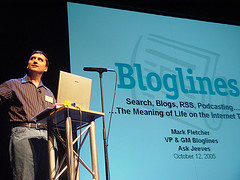Braintree’s Bryan Johnson will answer your questions in the comments section.
 In 2003, Bryan Johnson (right) was hired for a commission-only job selling credit card services to businesses. “I was broke,” says Johnson. “The job was brutal. Business owners were tired of the industry’s deception and trickery and didn’t hesitate when given an opportunity to vent.”
In 2003, Bryan Johnson (right) was hired for a commission-only job selling credit card services to businesses. “I was broke,” says Johnson. “The job was brutal. Business owners were tired of the industry’s deception and trickery and didn’t hesitate when given an opportunity to vent.”
Johnson quickly excelled, though. He became the top salesperson out of 400 nationwide and broke the existing sales record during his first year. His secret? “I simply figured out that businesses were looking for thee things: honesty, education and reliable service. I filled that gap and was received warmly. I also worked my tail end off.”
But by 2007, Johnson was sick of working for a big corporation. He says, “I concluded that I’d rather live poor and hungry than work in a large, bureaucratic and political environment where I personally couldn’t see how my efforts created value.”
He started figuring out what it would take to do his own thing. “I figured that I needed to make at least $2,100 a month to leave,” he explains. “My wife and I had learned to live quite frugally. I had started a few other businesses before, so this uncertainty and financial risk was something I was accustomed to. I had a single objective: Get back into the saddle. I was going to do whatever it took to get there.“
He took a few days off work and flew out to Utah, where his old customers resided. He asked them if they’d switch their processing to his new company, Braintree. Quite a few of them did, collectively generating $6,200 a month. Braintree was officially up and running.
Premium, not freemium
Early on, Johnson decided to stay away from the freemium model so popular among tech companies. “My experience in the payments industry told me it wasn’t for Braintree,” he explains. “We offer exceptional service during the sales and application process that continues after a merchant is set up with us. This level of service is too costly for a free account.”
So Braintree went the opposite route and charged a premium. It started with a $200 monthly minimum, which it’s since lowered to $75. “At $200, our minimum was 4 to 8 times higher than our competitors,” says Johnson. “Applying a floor helps the right kinds of customers self-select our services. After all, we’re as interested in having the right customers as they are in having the right provider.”
Who are the customers Braintree decided to write off? “It was a fool’s errand to try selling medicine to those who hadn’t yet experienced pain. Payment processing is complex. It’s difficult for inexperienced merchants to recognize value. We’d spend countless hours trying to explain ‘pain’ and our cure but some just didn’t care because they hadn’t felt it yet. With our limited resources, we had to figure out a way to work only with those who valued the medicine we were offering.
“We did take some grief for our higher minimums, but when we did, we’d politely explain that there were other, less expensive options in the industry, which may have been a better fit. I think staying firm often created an inverse effect, causing people to value us more than they did initially.”
Revenue growth
The formula is working so far. In 2010, Braintree generated $4.5MM in revenue, grew from 15 to 24 employees (now over 30), and doubled its customer base, according to Johnson. It powers payments for companies like LivingSocial, Github, OpenTable, and Animoto. And 99% of its customers come through word-of-mouth. “We’re on track to do $8 or $9 million in revenue during 2011,” Johnson says. “We also expect to rank among the top 50 on this year’s Inc. 500 list.“
Johnson is quick to note the difference between Braintree and other emerging payment companies. He says, “Four of these companies have raised around $40 million each and have roughly 3-6 times the personnel we do.”
Johnson feels that necessitates a different approach. “For many, raising a lot of money is accompanied by baked-in assumptions for how a business should be built,” he says. “The playbook typically calls for a large executive team and a few layers of management, which is very expensive. I think VC-funded companies are more inclined to throw money and people at opportunities and problems. This approach works for some, but there are other ways to build a successful business. Growing on our own dollar has granted us the freedom to do what we want, when we want, and how we want.”
It also forces Braintree to embrace constraints. “Without outside capital, we have to make do with less,” says Johnson. “Constraints are a beautiful thing because they force creativity and precision. We don’t have the resources to throw after hit-or-miss hires or strategies. Bootstrapping a business requires a different mentality. It’s taught us to be frugal, hire slowly, and exercise caution as we grew the business. While companies that take funding can do those things, people have a tendency to behave differently when it’s not their money on the line.”
“People have a tendency to behave differently when it’s not their money on the line.”
Continued…





 With this approach, The Week is profitable and growing steadily. It’s on track to make $6.3 million this year and its total circulation has grown by 5x since it launched in 2001. (It’s not doing any original reporting though, so you could make a case that it’s just piggybacking on the efforts of others.)
With this approach, The Week is profitable and growing steadily. It’s on track to make $6.3 million this year and its total circulation has grown by 5x since it launched in 2001. (It’s not doing any original reporting though, so you could make a case that it’s just piggybacking on the efforts of others.) Fletcher (right, in a photo by
Fletcher (right, in a photo by  In 2003, Bryan Johnson (right) was hired for a commission-only job selling credit card services to businesses. “I was broke,” says Johnson. “The job was brutal. Business owners were tired of the industry’s deception and trickery and didn’t hesitate when given an opportunity to vent.”
In 2003, Bryan Johnson (right) was hired for a commission-only job selling credit card services to businesses. “I was broke,” says Johnson. “The job was brutal. Business owners were tired of the industry’s deception and trickery and didn’t hesitate when given an opportunity to vent.”